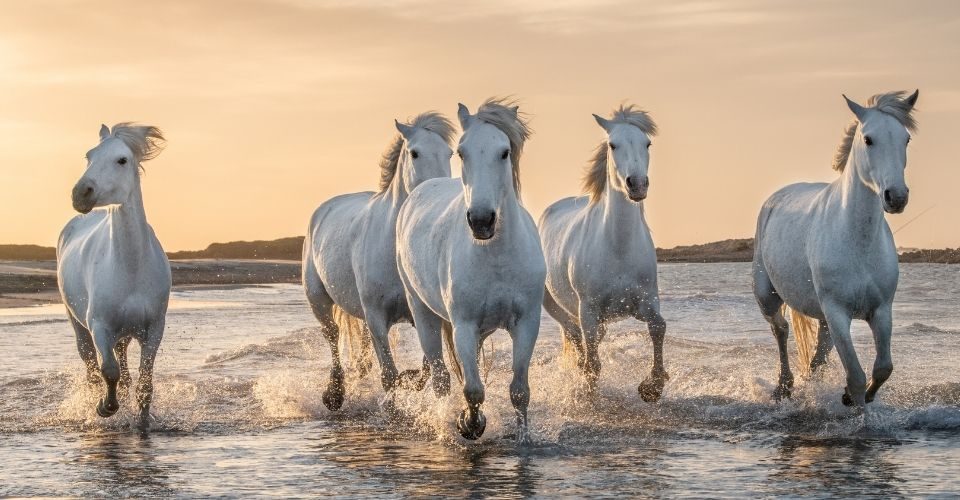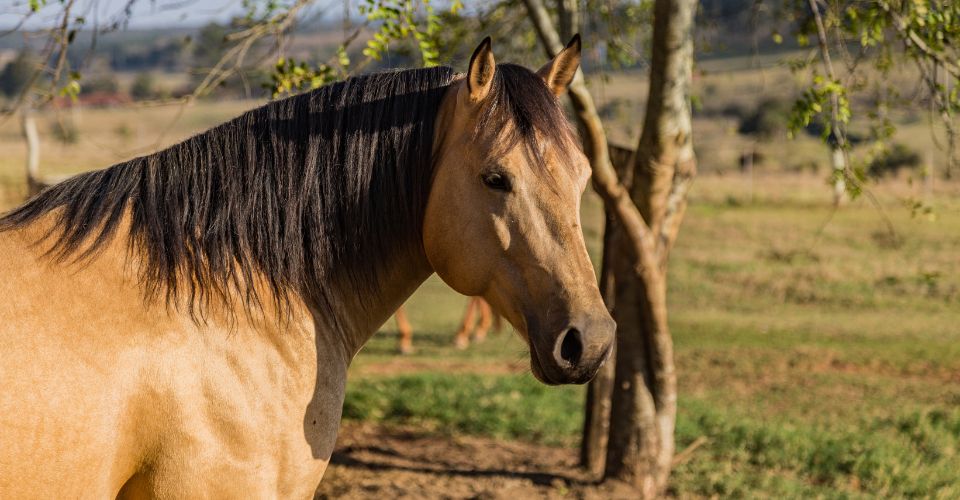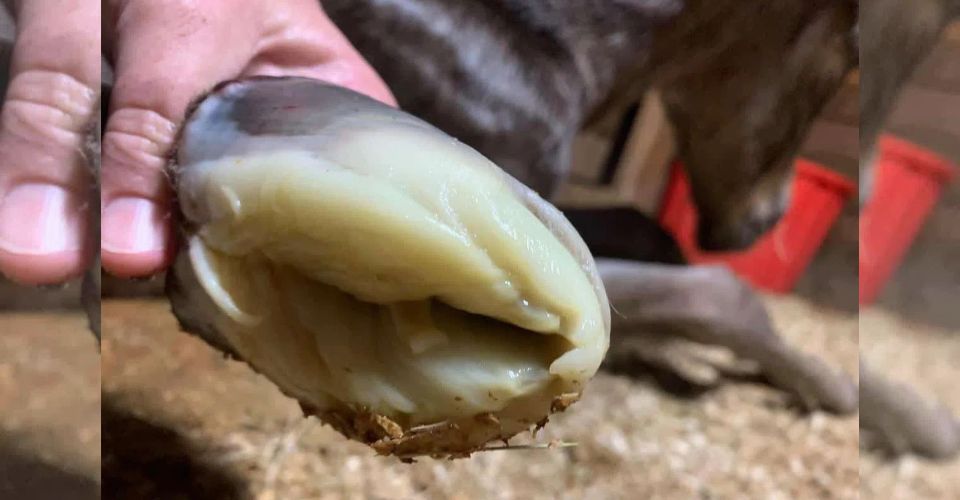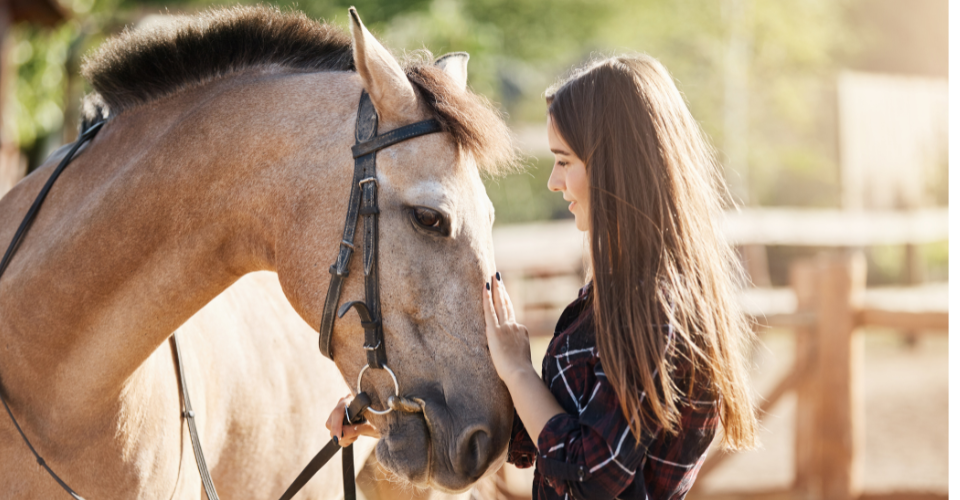Are you a history geek? If so, you would have come across warriors saddling horses coming across as heroes, as back as 5000 B.C. Any civilization that we have studied, or may study, has domesticated horses for their prowess at the battleground and many other faculties.
But you don’t have to be a history buff to get to the importance of horses in human history—and our evolution. Like any domesticated animal, horses have hundreds of breeds, each one best for a specific purpose. But how many breeds of horses are there in total? 10? 50? 100? Or, in thousands?
That, we will discuss here in the succeeding lines.
Origin of Horses
Horses are quite old creatures—originating roughly around 160,000 years ago in the steppes of Eurasia and were domesticated around 6,000 years ago.
According to a study, the modern-day breeds of horses have descended from two distinct lines, the Arabian horse and Turkoman horse (which is now extinct).
Over centuries, people crossbred horses selectively for horses with desirable characteristics. Because of this, we have a multitude of horse breeds today.
The first horse breed developed in America, the Morgan horse has a singular founding sire known as Figure. Given the prevalent practice of the day, Figure was named after his owner’s name—the Justin Morgan Horse. While the true origin of the Morgan horse is not known, it is believed that its founding sire, Figure, was a true Briton and considered a thoroughbred.
To create thoroughbred, English horse breeders mated the local riding horse with swift Arabians to get lean, super speedy horses—that would be used for racing.
In North America, domestic horses were introduced at the beginning of the Spanish conquest. But caballus already lived there around 1.7 million years ago.
How Many Breeds Of Horses Are There?
A group of horses having a common origin is termed a breed. This group of horses will have certain common characteristics that differentiate them from other horse breeds. Unless these horses are crossbred with horses of other breeds, their offspring will also have the same characteristics as their parents.
Based on these differentiating characteristics, horses are registered with local or national breed clubs, which gives us the idea of how many breeds of horses are there in the world.
So, how many breeds of horses are there?
We cannot tell you the exact number of horse breeds in the world but we can tell you is that there are more than 200 breeds of horses in the world, according to WebMD. The Breeds of Livestock Project of Oklahoma State University has listed a total of 217 horse breeds. If you count the number of horse breeds listed on Wikipedia, you will find out that there are more than 340 different breeds of horses.
The total number of horse breeds in the world keeps on increasing as breeders continue to crossbreed them to get horses with more desirable characteristics. Where some breeders are trying to produce more agile and smart horses that will help them herd other animals, others are breeding for speed to use them for racing purposes. For example, English horse breeders mated the local riding horse with swift Arabians to get lean, super speedy horses used in racing.
Categorization of Horses
As discussed above, there are over 200 breeds of horses globally, and they are increasing every year as people crossbreed them to get different breeds with different desirable characteristics. For better understanding, horses are categorized into different groups based on their color, size, or uses.
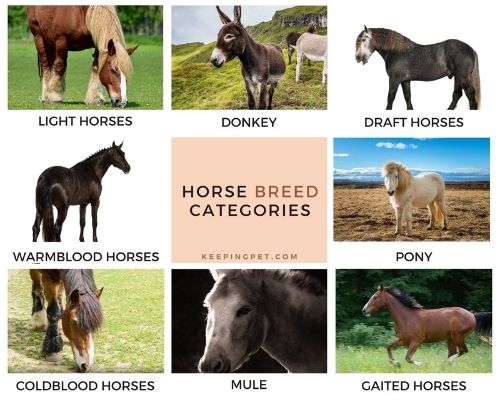
Primarily, there are two types of horses based on size.
- Ponies
- Horses
Horse size is measured in hands, and one hand is equal to 4 inches.
| Types of Horses Based on Size | Height Measurement |
| Ponies (small horses) | Below 14.2/14 hands height (hh) |
| Horses (tall horses) | 14.2 hh or above |
But based on their abilities, horses are broadly categorized into 6 following groups:
| Class of Horse | Size | Purpose | Features |
| Ponies | 137cm tall or less than 144 cm | Like other horses, they are bred for same purposes as horses, such as carrying burdens, riding, and pulling carts or wagons. | Ponies have dense bones, a stocky body, well-sprung ribs, and a round shape. They have short legs, heads, small ears, and large eyes. |
| Draft Horses | 163 – 193 cm height | To pull heavy loads and are also used as mounts (for officers) in the military. | Large horses with well-muscled builds. They have a docile temperament and sporting feathering on legs. |
| Gaited Horses | On average their height is 157 cm | Used for long-distance traveling because they are easy to ride and have a great deal of stamina. | They have a four-beat gait—each foot hitting the ground independently. If observed from the side, their legs of one side move forward simultaneously. |
| Light Horses | 122 – 175 cm height | They are used for riding and herding and are famous for their racing prowess. | Light horses are small (miniature) horses with thin legs and small bones. Light horses are used for ranch work but primarily used for recreation or shows. |
| Warmblood Horses | 160 – 170 cm height | These sporting horses are usually found in Olympic equestrian events. They have athletic abilities with high stamina. | They have a deep chest, smooth topline, and straight and long back. Their tail is high and extended legs with well-muscled and powerful hindquarters. |
| Coldblood Horses | On average 210 cm height | They are used for carrying and pulling heavy loads. | They have large shoulders and legs, with kind eyes and have a slight Roman profile on their head. Their feet are large and have an abundance of feathers. |
Ponies
Ponies are different from other horses based on their phenotype. In addition to their small height, they have short legs. Sometimes people confuse ponies with baby horses. But they are not baby horses—where a baby horse will grow to the size of the fully-grown horse above 14.2/14.3 hh, fully grown ponies are shorter than 14.2/14 hh.
Draft Horses
Draft horses are also known as heavy horses or workhorses. The word “draft” is derived from the old English word “dragan,” which means “to haul or draw.” There are many breeds of draft horses, but they share the same characteristics of patience, strength, and docile temperature.
The Clydesdales and Shire are considered the most famous draft horses.
Gaited Horses
Gaited horses are known as saddle-breeds. They are famous for their ambling gaits, which allow them to move all their legs independently. Meaning that, while walking or running, their one foot always remains on land, making them smooth-to-ride horses.
Light Horses
Light horses are smaller than draft horses. Modern-day light horse breeds are used for riding or light work. Thoroughbred of Arabian horses, they originated in North Africa and the Middle East.
Morgan, the first American-bred horse breed, is one of the famous light horse breeds.
Warmblood Horses
Warmblood horses are known as middleweight horses. They originate from Europe and are bred for racing purposes.
Warmbloods are named because of their pedigree which includes hot and coldblood horses—making them a mix of hot (Arabians and Thoroughbreds, etc.) and coldblood horses (Shires and Irish Draughts, etc.). They are known for their intelligence and calm temperament.
Coldblood Horses
Coldblood horses are huge and heavy draft horses and are used for pulling heavy loads. They were also used by the medieval knights to carry the weight of their armors. These horses have a quiet disposition and calm temperament.
Common Horses Breeds vs. Rare Horses Breeds
A brief overview of common and rare horse breeds is offered below.
Common Horse Breeds
These horse breeds are readily available and considered low-maintenance horses. In addition, these horses are usually famous for their pulling and carrying abilities.
In their native regions, these horses are common, but in other regions, they might be rare to find.
| Horses | Classification | Origin |
| Chickasaw | Light Horse | US |
| Belgian | Draft Horse | Belgium |
| Dutch Warmblood | Warmblood Horse | Holland |
| Highland | Pony | Scotland |
Rare Horse Breeds
According to ALBC (American Livestock Breeds Conservancy), a breed is considered rare if there are less than 1000 North American registrations and less than 5000 registration worldwide annually. But not all are rare horses are considered critical. A breed is deemed critical only when it is on the verge of extinction.
Below we have mentioned some of the rare and critical horse breeds.
| Rare Horses | Critical Horses |
| Canadian | Akhal Teke |
| Dartmoor | Caspian |
| Hackney | Cleveland Bay |
Other Breeds of Horses
There are some other breeds of horses that are used domestically or are present in the wild.
Feral Horses
Feral horses are also known as mustangs. They were once domesticated but now live in the wild. They are inhabitants of Colorado, Montana, California, Nevada, and New Mexico.
Donkeys
Donkeys were registered as a horse breed in 1968; they are domestic members of the horse family, primarily used as working animals or as pets in some countries. Below are few famous breeds of donkeys.
- The Mammoth Jack
- Large Standard Donkey (Spanish Donkey)
- Standard Donkey
- Miniature Mediterranean Donkey
American Spotted Mules
A mule results from the crossbreeding of a female horse and a male donkey. They have the body shape and height of horses, but their features resemble donkeys. Cross between a male horse and a female donkey is known as a hinny. A hinny is short in height like a donkey and has features that resemble horses.
Mules are classified into 5 breeds.
- Draft Mule
- Farm Mule
- Sugar Mule
- Cotton Mule
- Pack and mining Mule
So how many breeds of horses are there? As discussed above, the exact number of breeds of horses is not known as new breeds of horses keep emerging every year. But there are more than 200 breeds of horses that are registered with local or national clubs.
How many breeds of horses do you know about? Let us know on our social media pages.

